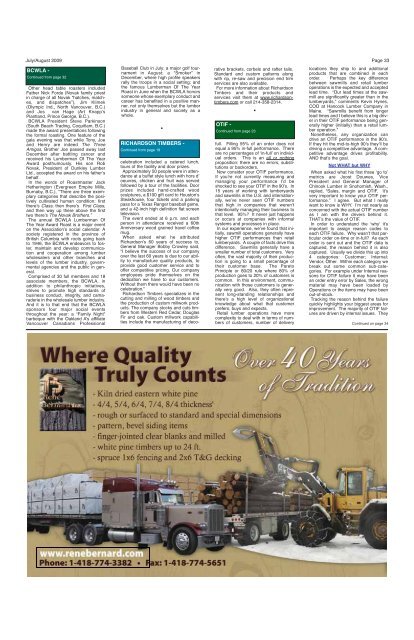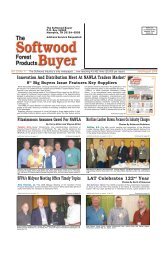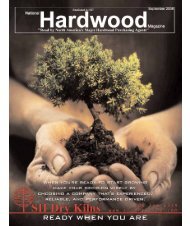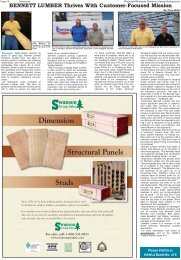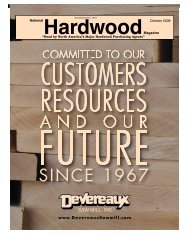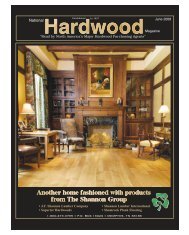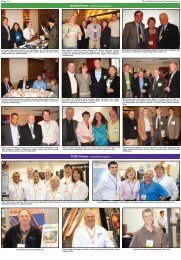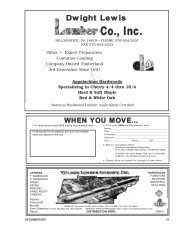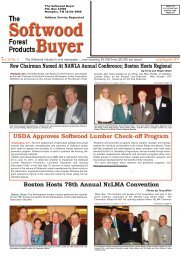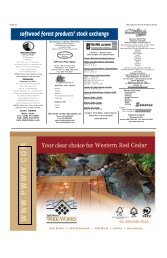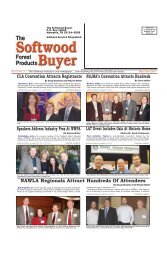Continued On Page 34 - Miller Publishing Corporation
Continued On Page 34 - Miller Publishing Corporation
Continued On Page 34 - Miller Publishing Corporation
You also want an ePaper? Increase the reach of your titles
YUMPU automatically turns print PDFs into web optimized ePapers that Google loves.
July/August 2009 <strong>Page</strong> 33BCWLA -<strong>Continued</strong> from page 32Other head table roasters includedFather Nick Forde (Novak family priestin charge of all Novak “hatches, matches,and dispatches”), Jim Klimek(Olympic Ind., North Vancouver, B.C.)and Jos van Hage (Art Knapp’sPlantland, Prince George, B.C.).BCWLA President Steve Parkinson(South Beach Trading, Coquitlam, B.C.)made the award presentations followingthe formal roasting. <strong>On</strong>e feature of thegala evening was that while Tony, Joeand Henry are indeed The ThreeAmigos, Brother Joe passed away lastDecember after battling cancer andreceived his Lumberman Of The YearAward posthumously. His son RobNovak, President of Dunkley LumberLtd., accepted the award on his father’sbehalf.In the words of Roastmaster JackHetherington (Evergreen Empire Mills,Burnaby, B.C.), “There are three exemplarycategories that describe the positivelycultivated human condition: firstthere’s Class, then there’s First Class,and then way up there above the firsttwo there’s The Novak Brothers.”The annual BCWLA Lumberman OfThe Year Award Roast is a major eventon the Association’s social calendar. Asociety registered in the province ofBritish Columbia with roots going backto 1946, the BCWLA endeavors to foster,maintain and develop communicationand cooperation among lumberwholesalers and other branches andlevels of the lumber industry, governmentalagencies and the public in general.Comprised of 30 full members and 18associate members, the BCWLA, inaddition to philanthropic initiatives,strives to promote high standards ofbusiness conduct, integrity, and camaraderiein the wholesale lumber industry.And it is to that end that the BCWLAsponsors four major social eventsthroughout the year: a “Family Night”barbeque with the Oakland A’s affiliateVancouver Canadians ProfessionalBaseball Club in July; a major golf tournamentin August; a “Smoker” inDecember, where high profile speakersrally the troops in a social setting; andthe famous Lumberman Of The YearRoast in June when the BCWLA honorssomeone whose exemplary conduct andcareer has benefited in a positive manner,not only themselves but the lumberindustry in general and society as awhole.RICHARDSON TIMBERS -<strong>Continued</strong> from page 19•celebration included a catered lunch,tours of the facility and door prizes.Approximately 50 people were in attendanceat a buffet style lunch with hors d’oeuvres, chicken and fruit was servedfollowed by a tour of the facilities. Doorprizes included hand-crafted woodsculptures, a $100 gift card to Houston’sSteakhouse, four tickets and a parkingpass for a Texas Ranger baseball game,and a 42-inch high definition flat screentelevision.The event ended at 6 p.m. and eachperson in attendance received a 60thAnniversary wood grained travel coffeemug.When asked what he attributedRichardson’s 60 years of success to,General Manager Bobby Crowley said,“I believe the success of our companyover the last 60 years is due to our abilityto manufacture quality products, toprovide good customer service and tooffer competitive pricing. Our companyemployees pride themselves on thededication we have to our customers.Without them there would have been nocelebration.”Richardson Timbers specializes in thecutting and milling of wood timbers andthe production of custom millwork products.The company stocks and cuts timbersfrom Western Red Cedar, DouglasFir and oak. Custom millwork capabilitiesinclude the manufacturing of decorativebrackets, corbels and rafter tails.Standard and custom patterns alongwith rip, re-saw and precision end trimservices are also available.For more information about RichardsonTimbers and their products andservices visit them at www.richardsontimbers.comor call 214-358-2314.•OTIF -<strong>Continued</strong> from page 23full. Filling 95% of an order does notequal a 95% in-full performance. Thereare no percentages of ‘in-full’ on individualorders. This is an all or nothingproposition: there are no errors, substitutionsor backorders.Now consider your OTIF performance.If you’re not currently measuring andmanaging your performance I’d beshocked to see your OTIF in the 90’s. In15 years of working with lumberyardsand sawmills in the U.S. and internationally,we’ve never seen OTIF numbersthat high in companies that weren’tintentionally managing their business tothat level. 95%? It never just happensor occurs at companies with informalsystems and processes in place.In our experience, we’ve found that initially,sawmill operations generally havehigher OTIF performances than retaillumberyards. A couple of facts drive thisdifference. Sawmills generally have asmaller number of total customers. Veryoften, the vast majority of their productionis going to a small percentage oftheir customer base. The ParetoPrinciple or 80/20 rule where 80% ofproduction goes to 20% of customers iscommon. In this environment, communicationwith those customers is generallyvery good. Also, they often representlong-standing relationships andthere’s a high level of organizationalknowledge about what that customerprefers, buys and expects.Retail lumber operations have morecomplexity to deal with in terms of numbersof customers, number of deliverylocations they ship to and additionalproducts that are combined in eachorder. Perhaps the key differencebetween sawmills and retail lumberoperations is the expected and acceptedlead time. “Our lead times at the sawmillare significantly greater than in thelumberyards,” comments Kevin Hynes,COO at Hancock Lumber Company inMaine. “Sawmills benefit from longerlead times and I believe this is a big driverin their OTIF performance being generallyhigher (initially) than a retail lumberoperation.”Nonetheless, any organization candrive an OTIF performance in the 90’s.If they hit the mid-to-high 90’s they’ll bedriving a competitive advantage. A competitiveadvantage drives profitability.AND that’s the goal.Not WHAT but WHYWhen asked what his first three ‘go to’metrics are Joost Douwes, VicePresident and General Manager ofChinook Lumber in Snohomish, Wash.,replied, “Sales, margin and OTIF. It’svery important to know your OTIF performance.”I agree. But what I reallywant to know is WHY. I’m not nearly asconcerned with the actual OTIF numberas I am with the drivers behind it.THAT’s the value of OTIF.In order to understand the ‘why’ it’simportant to assign reason codes toeach OTIF failure. Why wasn’t that particularorder on-time or in-full? As eachorder is sent out and the OTIF data iscaptured, the reason behind it is alsocaptured. Usually we divide this up into4 categories: Customer; Internal;Vendor; Other. Within each category webreak out some common sub-categories.For example under Internal reasonsfor OTIF failure it may have beenan order entry error by Sales, the wrongmaterial may have been loaded byOperations or the items may have beenout-of-stock.Tracking the reason behind the failurequickly highlights your biggest areas forimprovement. The majority of OTIF failuresare driven by internal issues. They<strong>Continued</strong> on page <strong>34</strong>


